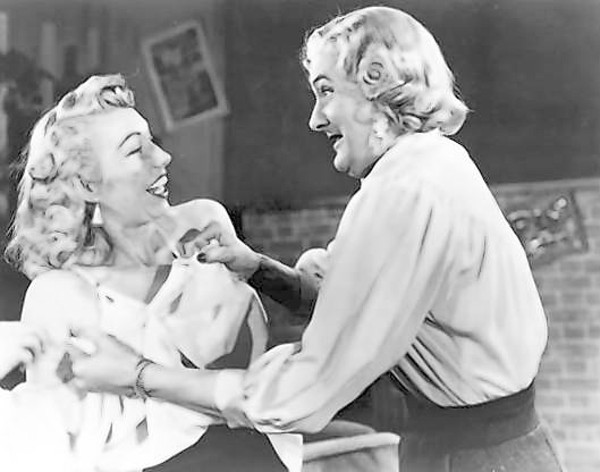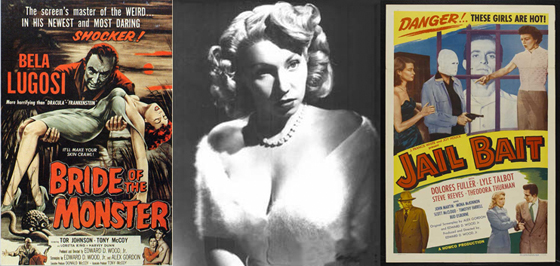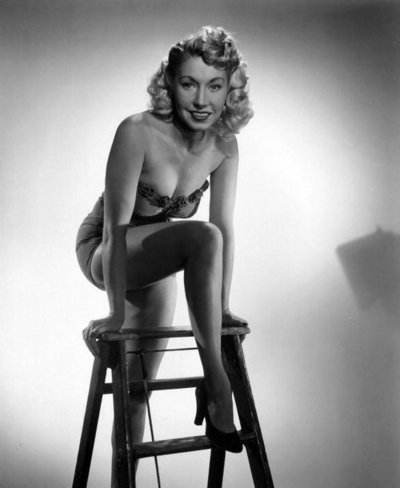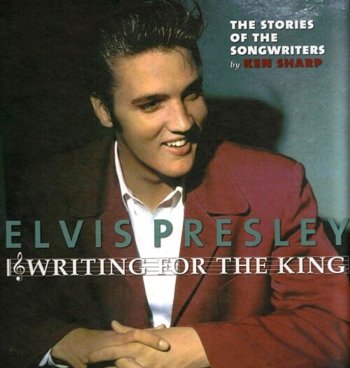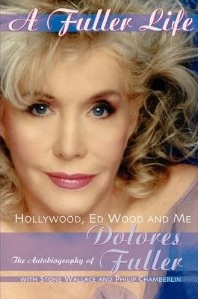Dolores Fuller (left) and Ed Wood in Glen or GlendaLook Back In Angora
From Ed Wood to Elvis: Dolores Fuller’s Amazing Odyssey
(March 10, 1923-May 9, 2011)
By David McGee
Give credit where credit is due: Dolores Fuller was never a star, but in a career that began with a bit part in Frank Capra’s 1934 Carole Lombard-Clark Gable classic, It Happened One Night, she fashioned one of the most interesting show business careers on record. When she died in her Las Vegas home on May 9, following a long illness, her passing was noted throughout the mainstream media and in dozens, if not hundreds, of blogs of various types. It’s not every day when you can write up the life of a woman who not only starred in one of the worst movies of all time but also dated its cross dressing director, then changed careers, became a songwriter and placed a dozen or so of her tunes in Elvis Presley movies.
Fuller wrote her name large, if infamously, in film history as the co-star of director Ed Wood’s attempt at a sensitive examination of cross dressing and transexuality in 1953’s Glen or Glenda. Playing the cross dressing, angora sweater-fixated Glen himself, Wood, a notorious transvestite, cast his real-life girlfriend, Fuller, as his screen fiancée, along with a sadly diminished Bela Lugosi in a role identified only as the Scientist, who primarily makes outlandish, bizarre statements about the fate of humanity and fancies himself a puppetmaster who can control the fate of his fellow humans (“Pull da strings!” he would cry over stock footage of stampeding buffalo, which, by the by, were not part of the story). Beyond that, Glen or Glenda was a typical Ed Wood film in which the wheels come off in the first few minutes and it never recovers, while achieving a surreal, mesmerizing awfulness of an awe inspiring dimension previously unknown even in low-budget B movies. Glen or Glenda, however, was but prelude to Wood’s true masterpiece of inspired lunacy and makeshift props and plotting, a science fiction nightmare for which Wood had high hopes, 1959’s Plan 9 from Outer Space. Not only was it a monumental box office bomb, it regularly shows up atop lists of the worst films ever made.
‘The story is begun’: a priceless 11-minute segment of Glen or Glenda, with director Ed Wood Jr. as Glen, ‘man and woman in the same body,’ and Barbara (Dolores Fuller) as a real woman engaged to Wood.Born March 10, 1923, in South Bend, IN, Dolores Fuller grew up in California, where her family moved when she was 10. While the Fullers were staying in a motel in El Monte young Dolores was hired as a background extra in It Happened One Night, which was shooting at the motel.
She was a bit movie player, a model on TV's Queen for a Day and Dinah Shore's stand-in on the star's musical TV show when she responded to a casting call and met Wood in late 1952.
"When I got to the casting call and first laid eyes on the young Edward, I just thought he was extremely handsome, and his personality was bubbly and fun," Fuller recalled in a 1994 interview with Tom Weaver for Fangoria magazine.
"Then when I found out he was also a director and writer as well as a producer and actor, I was very impressed. … I knew immediately that he liked me, too."
The divorced Fuller was soon cohabitating with Wood, who cast her in Glen or Glenda. Fuller told Fangoria interview she "didn't know Eddie was a transvestite when we first got together—even the first year, I didn't know."
But then one evening, she recalled, Wood was writing "and he said he'd like to borrow my white angora sweater.
"I said, 'Why do you want to borrow it?' and he said, 'Well, it helps me write, I feel so much more comfortable. I hate men's hard clothes, I like soft, cuddly things. It makes my creative juices flow!' Well, we were all alone and I saw no harm in it. … That was my first inkling that maybe he had a fetish. But I didn't realize it went any further."
When she saw the final version of Glen or Glenda, in which Wood cavorts in a wig and women's clothing, Fuller said, "I wanted to crawl under the seat!"
Describing herself as the main source of income while she and Wood lived together, Fuller also starred in his 1954 crime thriller Jail Bait. She also had a small part in his 1955 horror film Bride of the Monster.
Wood told Fuller he had written Bride of the Monster intending for her to play the female lead, but then he gave the role to another actress. This slight, on top of Wood’s alcoholism, led Fuller to split up with him in 1955.
"He begged me to marry him,” she told Rudolph Grey in Nightmare of Ecstasy: The Life and Art of Edward D. Wood Jr. “I loved him in a way, but I couldn't handle the transvestism. I'm a very normal person. It's hard for me to deviate! I wanted a man that was all man. After we broke up, he would stand outside my home in Burbank and cry, ‘Let me in, I love you!’ What good would I have done if I had married him? We would have starved together. I bettered myself. I had to uplift myself."
The big finish of Glen or Glenda, with Bela LugosiShe moved to New York, where she studied with Stella Adler at the Actors Studio. "I decided I needed lessons after seeing Ed's films," she told the Kansas City Star.
A friendship with producer Hal Wallis led to her to a fruitful collaboration with composer Ben Weisman and a break writing "Rock-a-Hula Baby" for Elvis Presley's 1961 movie Blue Hawaii.
She went on to co-write other songs for a dozen Presley movies, including Roustabout (“Big Love, Big Heartache,” one of Elvis’s best moody ballads from the early post-Army years), Kid Galahad, It Happened at the World's Fair (“Beyond the Bend”), Fun in Acapulco (“You Can’t Say No In Acapulco”), Spinout (the title track) and Girl Happy (“Do the Clam”), as well as co-writing "Someone to Tell it To," recorded by Nat King Cole, and "Losers Weepers," for Peggy Lee.
In the late ‘50s she started her own record company, Dee Records. One of her discoveries was a native New Yorker singer-guitarist, John Ramistella, who later changed his name to Johnny Rivers.
Interest in Wood’s work was reignited by director Tim Burton’s 1994 biopic, Ed Wood, starring Johnny Depp as Ed Wood, Sarah Jessica Parker as Fuller and Martin Landau in an Oscar winning role as Bela Lugosi. "Ed always said he'd make me a star," Fuller told the Kansas City Star in ’94, after the movie became an unexpected box office success. "I just didn't realize it would take 42 years."
‘I loved that man. He was so talented.’ Dolores Fuller on Ed WoodFuller was critical of Parker’s portrayal of her in the film, telling an interviewer for Elvis Australia, “Sarah Jessica Parker smoked all the time. And I never would smoke. And she didn't contact me. Here she's playing my life, and she didn't bother to do any research. And when she was asked, on the David Letterman Show, by David Letterman, 'What's Dolores like, is she still alive? What did she do with her life?' she turned her head, because she didn't want to give me any air time. She said, 'I'm going home and have a ground glass cocktail.' You know, just ornery.
“I met her at the press party after the Ed Wood movie. And she said, 'I just got through telling everybody that I just played the part of the worst actress in the history of film.’ That wasn't nice, it wasn't professional. She didn't know me, you know. It hurt.”
She was more charitable in appraising Depp’s characterization of her former beau: “It was beautiful. Eddie was not always that up. He had his heartbreaks too. It was a little Andy Hardy, but oh, what a great actor he is. And I just loved the portrayal. He captured a great deal of Eddie’s personality.”
Fuller chronicled her life in her 2009 autobiography, A Fuller Life: Hollywood, Ed Wood and Me.
Fuller’s husband, film historian Philip Chamberlin, survives her, along with her son, Don; three grandchildren and numerous stepchildren and stepgrandchildren.
***
Dolores Fuller: ‘Elvis was very well mannered.’Elvis Called Her ‘Ma’am’
An Interview With Dolores Fuller
How did you get started writing songs for Elvis' movies?
Well I have to attribute my break in getting into songwriting to Hal Wallis. He was an old friend of mine, and when I was trying out for a part in the Blue Hawaii movie, he said, “Dolores, if you can write like this, why would you wanna be an actress? It's a much more rewarding career.” And goes on and on, the rest of your life. And so he says, “Tomorrow morning you be at Hill and Range and meet Freddy Bienstock and we'll put you with one of the writing teams.” The competition is terrible. Twelve teams of writers, the top writers in the country. Tepper and Bennett, Mack David, everybody trying for the title song. But I had had this background in acting. I would try for the dance number, and usually get it. Because I also had years of ballet training. And I could motivate the plot. In fact, when Spinout was given to me as a script, it was called Raceway. Joe Pasternak, an MGM picture. And I said, “Oh God, all these writers are gonna be trying for the title, I gotta think of something else.” So I wrote “Spinout” with Ben Weisman, and they liked it very much and changed the title of the movie.
Elvis, ‘Rock-a-Hula Baby,’ written by Dolores Fuller and Ben Weisman for the film Blue Hawaii (1961)What was it like to work with Elvis?
Well, you didn't really work with Elvis. If I was lucky, I was invited to the set, when they were shooting one of my songs. And Elvis was very well mannered, he called me ma'am. And he would sometimes invite me over to some party that was going on, when he lived over in Bel Air. And sometimes I'd have lunch with him at the commissary. But mainly you just worked with the publisher. And all these teams of writers would submit their songs, and I'm lucky enough to have gotten 12 movies. “Rock-A-Hula Baby” was probably the most important. “Do the Clam” and “Spinout.” “Got Lucky,” “Beyond the Bend,” “Cindy Cindy,” “Big Love, Big Heartache,” you know. Fun.
Elvis, ‘Big Love, Big Heartache,’ a Dolores Fuller song from Roustabout, and one of the King’s finest moody ballads of the early post-Army years.Tell us about Ed Wood.
Oh. I loved that man. He was so talented. And if he was only alive today to see what was going on, how many young film writers, producers, would-be producers, you know, associate themselves with him. They say, “If he did it, I can do it.” I met him when he was looking for somebody that he could groom. So I guess he interviewed a lot of young actresses. But I came in with an angora sweater. And he loved angora. And I had a couple of jobs and a car. So anyway, we fell in love and we became a team. We worked together as a team. And the way the Ed Wood movie is, you'd never know that. They portrayed me sort of as an actress just out to get what I could get as a part. But I contributed all the wardrobe because I worked for some of the top clothing manufacturers. So anything he wanted I could say, “Yes, we could use that for this scene and put their name on the screen.” He never had to worry about wardrobe for any of his pictures for the women.—
The full interview with Dolores Fuller is online at Elvis Australia
Dolores Fuller’s A Fuller Life: Hollywood, Ed Wood, and Me is available at www.amazon.com
Founder/Publisher/Editor: David McGee
Contributing Editors: Billy Altman, Laura Fissinger, Christopher Hill, Derk Richardson
Logo Design: John Mendelsohn (www.johnmendelsohn.com)
Website Design: Kieran McGee (www.kieranmcgee.com)
Staff Photographers: Audrey Harrod (Louisville, KY; www.flickr.com/audreyharrod), Alicia Zappier (New York)
E-mail: thebluegrassspecial@gmail.com
Mailing Address: David McGee, 201 W. 85 St.—5B, New York, NY 10024


